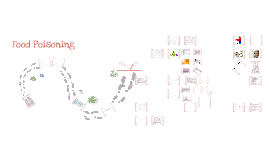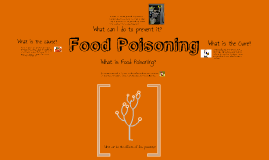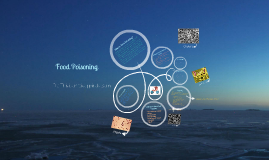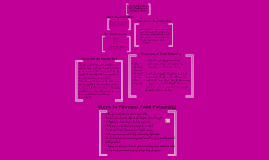Food Poisoning
Transcript: Avoid alcoholic, caffeinated, or sugary drinks, if possible Sports drinks such as Gatorade and Powerade are fine for adults if they are diluted with water because at full strength they contain too much sugar, which can worsen diarrhea. After successfully tolerating fluids, eating should begin slowly, when nausea and vomiting have stopped Based on pathogenesis a. Food intoxications resulting from the ingestion of preformed bacterial toxins. (Staphylococcus aureus, Bacillus cereus, Clostridium botulinum, Clostridium perfringens) b. Food intoxications caused by noninvasive bacteria that secrete toxins while adhering to the intestinal wall (Enterotoxigenic E.coli, Vibrio cholerae, Campylobacter jejuni) c. Food intoxications that follow an intracellular invasion of the intestinal epithelial cells. (Shigella, Salmonella) d. Diseases caused by bacteria that enter the blood stream via the intestinal tract. (Salmonella typhi, Listeria monocytogenes Ways to break the Chain Campylobacter: Campylobacter is the most commonly identified food-borne bacterial infection encountered in the world. Causes mild illness with fever, watery diarrhea, headache, and muscle aches. Probiotic B)Inflammatory diarrhea is caused by the action of cytotoxin on the mucosa, leading to invasion and destruction. The colon or the distal small bowel commonly is involved. The diarrhea usually is bloody; mucoid and leukocytes are present. Patients are usually febrile and may appear toxic. Dehydration is less likely than with noninflammatory diarrhea because of smaller stool volumes. Fecal leukocytes or a positive stool lactoferrin test indicates an inflammatory process, and sheets of leukocytes indicate colitis. Children and adults who are severely dehydrated need treatment in a hospital, where they can receive salts and fluids through a vein (intravenously), rather than by mouth . Intravenous hydration provides the body with water and essential nutrients much more quickly than oral solutions do Keeping high-risk foods at temperatures that inhibit the growth of bacteria (i.e. out of the temperature danger zone). Food should be kept below 4°C in a refrigerated unit or above 70°C in a suitable warming unit. Ensuring that during preparation, food is in the danger zone for as short a time as possible. High-risk foods must not be left sitting out at room temperature. Ensuring the rapid cooling of large quantities of cooked food by dividing into smaller lots and refrigerating in shallow containers less than 10 cm deep. Using suitable preservatives. Using appropriate packing methods (like gas flushing or vacuum packing) for food products. Preventing dried foods from absorbing moisture. Serving food as soon as possible after preparation. - Short episodes of vomiting and small amounts of diarrhea lasting less than 24 hours can usually be cared for at home . Do not eat solid food while nauseous or vomiting but drink plenty of fluids. Small, frequent sips of clear liquids (those you can see through) are the best way to stay hydrated. Bacterial Multiplication Food Poisoning Cont. Presented by: Food hygiene . Personal hygiene . Environmental hygiene . Antibiotics The doctor may need to do a rectal examination. The doctor performs this test by inserting a lubricated and gloved finger gently into the rectum. The purpose is to make sure there are no breaks in the rectal wall. A sample of stool is taken and tested for blood and mucus. In some cases, a sample of stool or vomit can be sent to the laboratory for further testing to find out which toxin caused the illness. In a majority of cases, a specific cause is not found. A urine sample helps assess how dehydrated the patient is and may indicate possible kidney damage. Blood tests may be performed to determine the seriousness of the illness. An X-ray of the abdomen or a CT scan may be taken if the doctor suspects the patient's symptoms may be caused by another illness. Viruses Pathophysiology (3) Water- Bacteria need moisture for growth. Without water, dehydration occurs and the life and growth of the bacteria will slow down and may stop. - This is why drying and salting are effective methods of preserving foods. (3) Water- This is a scale indicating the acidity or alkalinity of a fluid. Bacteria grow and multiply only within a certain ph range with most preferring a neutral environment around pH 7, while a small group prefer an acid environment. Salmonellae: cause a moderate illness with nausea, vomiting, crampy diarrhea, andheadache, which may come back a few weeks later as arthritis (joint pains). In people with impaired immune systems (such as people with kidney disease,HIV/AIDS, or those receiving chemotherapy for cancer), Salmonellae can cause a life-threatening illness. Noroviruses a group of viruses that cause a mild illness (often termed "stomach flu") with nausea, vomiting, diarrhea, abdominal pain, headache, and low-grade fever. Rest Management Food Poisoning Diagnosis Thank you (2) Handling of food Food

















